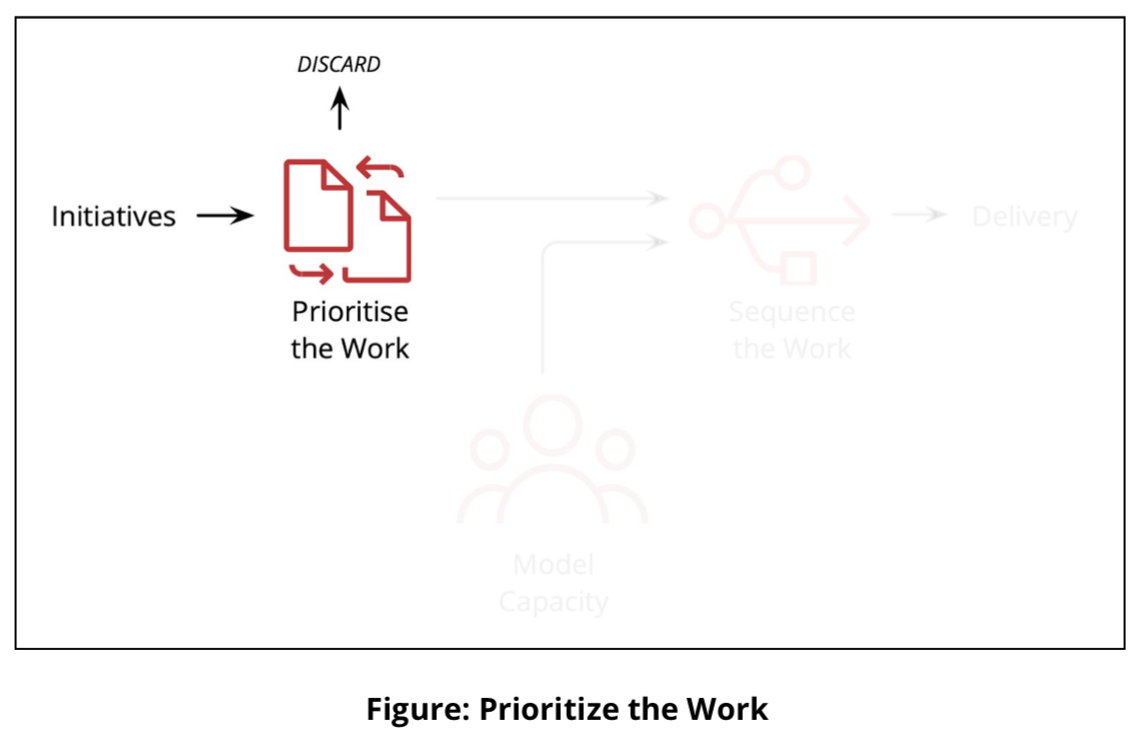
Part 1: Do the most valuable thing, unless you can't
Every organization has more things it wants to do than it can do. This is often viewed as a capacity problem; if only we had more capacity, we could get everything done. However, this is not true. All organizations have a finite capacity and from our experience, there is a law of diminishing returns where adding more and more people to increase capacity is actually counterproductive. In fact, it's how that capacity is allocated that matters.
Our limited capacity needs to be allocated to the most valuable work so that we do the things that are most important to our customers and the business first, while less important things get done later, or not at all. We need to know what is valuable, how much we can do, and in what order we should do it.
We often see managers, particularly senior managers, struggling to understand and appropriately engage with these concepts in a practical way; there is a general lack of good definitions of what is actually valuable, a lack of clarity on a realistic capacity to do work, and a lack of good mechanisms to manage the sequencing of work well.
In this three-part series, we're going to talk about all three problems and offer some suggestions on how to start to address these problems.
Prioritize according to value
Prioritizing work starts with a strategy. Strategy can be determined in many different ways but it's important that senior management is able to clearly articulate its strategy and determine some 'knock-out' criteria to quickly eliminate things that do not or will not contribute to the overall strategy. For instance, quickly eliminating a product or service, either current or in development, that contributes less than 5% of revenue, will get rid of a lot of distractions and waste and allow the business to focus on prioritizing really valuable work within its available capacity.
Prioritization itself is about ensuring we are clear about the value each piece of work or initiative will deliver so that we can allocate our limited resources appropriately. To effectively prioritize, we need to create, as much as possible, an objective view of what is important to the customer and the business and we do this by defining a set of value criteria and a common taxonomy or language. Accepting our limited resources as constraints, it is this set of value criteria and common language that allows us to make a balanced comparison between initiatives.
It is the conversations around the work, and the value that each will deliver, that provide the most benefit to an organization.

The following process works best when it's a regular, iterative activity. It needs to become a part of an organization's core operating rhythm. Early iterations will uncover wasteful, non-value work while later iterations will streamline the process of comparison and prioritization. As the process matures, the organization will become more adept at devising truly valuable initiatives (the consideration of value will gradually shift to be considered earlier in the process) and prioritization will be more about ordering initiatives rather than filtering.
A lightweight approach to governance is required to ensure the process delivers the desired outcomes and that ego, personal gain and politics are left at the door. Senior management is expected to own the strategy and value criteria and has the responsibility to challenge the projected efficacy of initiatives to deliver the strategy. General management and their leadership teams are expected to own the initiatives (along with their feasibility, capacity and capability to deliver) and have the responsibility to determine the priority order of work. Early iterations can benefit from an impartial facilitator but the expectation is that the process becomes self-managing as it matures.
1. Define work (initiatives) at the right scale
Attempting to prioritize large programs of work containing multiple projects often leads to them occupying the top of the backlog for long periods of time, potentially blocking important but smaller pieces of work from being done. So define initiatives as a single piece of work containing a number of work tasks or a number of pieces of work that all contain work tasks. A good rule of thumbs is, as long as the pieces of work share a common objective, they can sit within one initiative.We're often asked what is the 'right' size for initiatives. The answer is, it depends on your business. If you are planning on a quarterly basis, initiatives should fit within the planning period, so that you can review the outcomes at the end of the period and decide whether to proceed, change direction, or stop.
When breaking down larger pieces of work into smaller initiatives, we recommend against ‘horizontal slicing’ (i.e. doing all the groundwork, then doing the next level up, and so on). Instead create a ‘thin slice of value’ from top to bottom. This can look like a proof of concept, a reduced feature-set product, a prototype, or a localised improvement.
2. Define the value criteria and a qualitative scoring system
Value criteria (and the associated ranking scale) creates a common, qualitative, and importantly, a more objective language of value across the organization. By defining the value criteria and a qualitative scoring system (the calculator), initiatives can be quickly compared with each other. Examples of value criteria include customer value, business value, technology investment, and risk mitigation.
This runs contrary to traditional models of setting financial targets and then identifying activities to meet the targets. By defining value outcomes, initiatives are evaluated for their contribution of value. The impact on the bottom line becomes a secondary outcome of the work. Further, by allocating a number of inward-facing and outward-facing objectives, a balance can be struck between growing and strengthening, diversifying and consolidating.
It is possible to employ weightings to emphasise certain desired outcomes over the work planning period. However, one must be cautious of introducing confirmation bias. The weightings should be kept small to adjust focus (perhaps fractional values) and avoid swamping the influence of the value criteria. The value criteria with qualitative descriptions should be the primary method of prioritization and it is preferable to adjust and improve these rather than apply weighting factors to fix a poor scale.
3. Stack-rank the initiatives using the value criteria scores
Select the best qualitative description of the value created by the initiative and use the calculator to generate an initial stack-rank score. ‘Stack-rank’ simply means to organise the initiatives, physically as cards on a wall or virtually in some digital format, in order of their stack-rank scores.
Early attempts to evaluate initiatives may uncover the need to provide better quality information about each initiative. But this doesn't mean that a full business case is needed. Often a 'rapid discovery' can be used to determine minimum information on an A3 canvas. Typically the minimum information required to allow for a balanced comparison between initiatives is:
- a description of what the initiative will do for whom and why;
- what benefit it will provide (including measures that will shift); and
- what happens if we do nothing.
Armed with the information above, it is easier to compare initiatives based on their relative value to the customer and/or the business. The “what happens if we do nothing” piece of information is particularly useful in the conversations in the next step.
4. Review the stack-rank for realistic order of priority and accommodate exceptions
The initial stack-rank is used to create a quick priority order. The most important part of the prioritization process is the review - through conversation and debate - and adjustment of the order according to exceptions or other reasoning. As the order is adjusted, be sure to capture the assumptions made along the way as history of the decisions.
5. Apply trade-offs to create a final prioritized backlog
Trade-offs are used to discriminate between initiatives with the same priority and allow the prioritization team to determine which to prioritize. Use the “what happens if we do nothing” information to compare initiatives and identify significant benefit or opportunity loss.While the process above relies on scoring initiatives to determine an initial ranking, it is the conversations around the work, and the value each will deliver, that provide the most benefit to an organization. All scoring models are imperfect so don’t be afraid to make small adjustments to the list of initiatives using trade-offs and comparisons until it makes sense; adjust the criteria and model, if need be, to embed improvements as you learn what works. With practice, the process will rely less and less on the scores and more on the initiative owners understanding the relative value of their work aligned to the organizational strategy.
In the second part of this article we look at capacity as a constraint and discuss how we might model our available and effective capacity to help in the sequencing of work.
Disclaimer: The statements and opinions expressed in this article are those of the author(s) and do not necessarily reflect the positions of Thoughtworks.

















